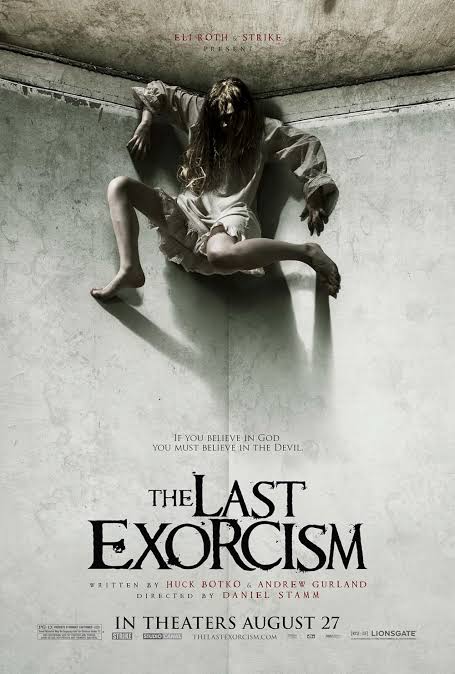Read our in-depth review of The Last Exorcism (2010) – a chilling found footage horror film that blends psychological tension with supernatural scares. Is it truly the last? Find out here.

The Last Exorcism (2010) – Movie Review
Best Movie Review (BMR) Rating: 7.5/10
Genre: Horror, Thriller, Found Footage
Director: Daniel Stamm
Cast: Patrick Fabian, Ashley Bell, Iris Bahr, Louis Herthum
Runtime: 1h 27m
Release Date: August 27, 2010
Language: English
Production Company: Strike Entertainment, StudioCanal
Streaming On: Amazon Prime Video
Introduction
In the wake of the Paranormal Activity and Blair Witch Project phenomenon, The Last Exorcism arrived in 2010 as another found footage horror film—but this one set its sights on the timeless horror subgenre of demonic possession. Directed by Daniel Stamm and produced by horror icon Eli Roth, the film explores the blurry line between psychological trauma and genuine evil, offering a slow-burn, documentary-style look into a so-called exorcist’s last mission.
The question it asks is haunting: what happens when a man who doesn’t believe in demons comes face-to-face with something he can’t explain?
Plot Overview
The story follows Cotton Marcus (Patrick Fabian), a disillusioned evangelical minister who has performed exorcisms for years—without believing in them. Viewing his work as a psychological placebo more than a spiritual act, Cotton invites a documentary crew to follow him on his “last exorcism,” intending to expose the industry as a fraud.
He receives a letter from Louis Sweetzer, a devout farmer in rural Louisiana, who believes his teenage daughter Nell (Ashley Bell) is possessed by a demon. Cotton agrees to visit the Sweetzer family and perform a fake exorcism—expecting to calm Nell and walk away feeling vindicated. But once he arrives at the secluded farm, strange occurrences begin to escalate. Nell’s behavior becomes increasingly disturbing, and what initially seems like mental illness may actually be something far more sinister.
As events spiral out of control, the line between skeptic and believer starts to fade.
Performances
Patrick Fabian delivers a commanding and layered performance as Cotton Marcus. Charismatic, arrogant, and at times genuinely compassionate, his portrayal of a man grappling with faith and deception is one of the film’s highlights. He brings credibility to a character that could have easily been played for cheap laughs or simple mockery.
Ashley Bell is hauntingly effective as Nell. Her ability to switch between innocence and menace is truly unsettling, and her contortionist scenes are made even more terrifying by the fact that no CGI was used—Bell performed all the movements herself. Her performance is both emotionally vulnerable and physically intense, elevating the film above standard horror fare.
The supporting cast, particularly Louis Herthum as Nell’s father and Caleb Landry Jones as her brother, add a layer of eerie authenticity to the backwoods setting.
Direction & Cinematography
Daniel Stamm uses the found footage style with surprising restraint and intelligence. The film begins as a faux-documentary, with handheld camera work, interviews, and a naturalistic shooting style. Unlike some entries in the genre, The Last Exorcism avoids excessive shaky cam or cheap jump scares in favor of building dread through atmosphere, silence, and suggestion.
As the story progresses, the documentary lens becomes a tool for immersive storytelling, making the horror feel immediate and personal. The Louisiana setting is captured with an eerie, almost pastoral beauty, contrasting the horror to come.
Horror Elements & Atmosphere
The film relies more on psychological tension than gore or violence. Creepy sounds in the night, subtle changes in Nell’s behavior, and disturbing drawings slowly build a sense of dread. The exorcism scene itself is unnerving without being over-the-top, and the suspense escalates to an ambiguous, divisive climax.
The Last Exorcism plays with audience expectations. Is Nell mentally ill, traumatized, or truly possessed? Is Cotton confronting a hoax or genuine evil? These unanswered questions create a deeper sense of fear—one rooted in uncertainty rather than spectacle.
Themes & Symbolism
At its core, the film explores themes of faith, deception, and exploitation. Cotton Marcus represents modern cynicism—someone who has lost belief in both religion and himself. Nell, by contrast, represents innocence corrupted by forces (both human and possibly supernatural) that she can’t control.
The film also critiques the exorcism industry, highlighting how religious rituals can be misused or misunderstood in dangerous ways. Yet, by the final act, it complicates this message—suggesting that perhaps not all of Cotton’s exorcisms were fake.
Strengths
- Strong lead performances, especially Patrick Fabian and Ashley Bell
- Smart use of the found footage format
- Slow-building tension and psychological horror
- Themes that go beyond typical genre clichés
- Effective blend of ambiguity and terror
Weaknesses
- The ending is polarizing and may not satisfy all viewers
- Some pacing issues in the mid-section
- Found footage format might feel overdone for some audiences
- Lacks gore or jump scares for those who prefer more visceral horror
Conclusion
The Last Exorcism isn’t just another exorcism film—it’s a thoughtful, chilling take on belief and manipulation, delivered through a convincingly raw found footage lens. With standout performances and a deeply unsettling atmosphere, the film keeps you questioning what’s real, what’s not, and whether faith can survive fear.
Though its ending may divide audiences, it succeeds in leaving a lasting impression. For fans of psychological horror, ambiguous storytelling, and stripped-down scares, this one is worth your time.
BMR Rating: 7.5/10
A smart, eerie twist on the exorcism genre with powerful performances and an ending that lingers